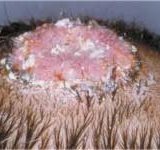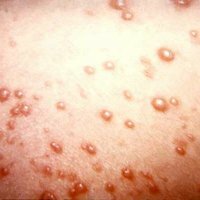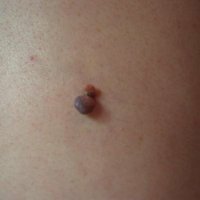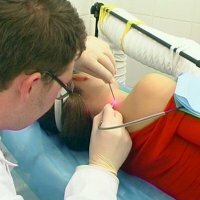Ringworm: Symptoms and Treatment

Ringworm is a type of fungus that causes damage to the hair and skin, and very rarely can appear on the nail plates. The name of this disease appeared on behalf of its pathogen, namely, the fungus of the genus Microsporum.
Upon contact with the skin, the fungus begins to multiply on it. Since the fungus spores settle next to the hair follicles, they damage their structure and roots. Very quickly moving along the surface of the hair, the fungus breaks the cuticle, among the scales of which they accumulate their spores. The fungus envelops the hair, forming a cover, and clogs the bulb.
The most famous fungal infection after the foot fungus is ringworm. The disease is everywhere. Ringworm is characterized by high infectiousness, most often infected with children. Adults are rarely infected - young women have the advantage. Rarely does anyone suffer from ringworm in adulthood, especially with the infection of the scalp, and usually the ongoing self-recovery during the transition to adolescence is due to the presence of organic acids in the hair of adults stopping the growth of the fungus.
The main source of the disease are cats( usually kittens), very rarely dogs. There is a ringworm infection by direct contact with an infected animal or objects on which there is hair or scales. In soil with affected hair or scales, the fungus lives for 1-3 months. Soil is only a factor in the transmission of infection and is not its natural source.
Ringworm. Symptoms and signs of appearance.
Manifestations of hair loss in animals are observed baldness on the muzzle, ears, as well as on the front and very rarely hind legs. Often apparently healthy cats can become carriers of the fungus. Seasonal fluctuations in morbidity are inherent in the appearance of offspring in cats, as well as very frequent contact of children with animals in the summer. The increase in the incidence of ringworm is evident at the end of summer, the peak is in October-November, the risk of the disease decreases by March-April.
With zoonotic ringworm, the incubation period lasts for 5-7 days. The frequency of the appearance of ringworm is due to the deep penetration of the pathogen and the location of lesions. There is ringworm, which appears on the hair and the lichen of the smooth skin of the head part.
Diagnosis of Ringworm.
Diagnosis is performed by a dermatologist.
For the diagnosis of ringworm, luminescent, culture and microscopic studies are used.
Fluorescent study: this method is based on the detection of a bright green shine of hair infected with fungi of the genus Microsporum when viewed under a Wood lamp. The reason for this phenomenon could not be established before. Luminescent research is carried out in a dark room. The lesions are initially cleared from crusts, ointments, etc. When examining new foci, glow may not be, it is due to insufficiently affected hair. In these situations, the hair needs to be removed from the suspected infected area by the fungus, and the radiance can be found in their root part. Glow in the hair persists even when the fungus is killed.
Treatment of ringworm with medicines.
To treat ringworm skin without the defeat of hair using antifungal agents for external use. On the lesions in the morning it is necessary to apply 2-5% tincture of iodine, and in the evening lubricate with antifungal ointment. Traditional 10-20% sulfuric, 10% sulfuric-3% salicylic or 10% sulfur-tar ointments are also used. Twice a day it is necessary to use modern ointments: "cyclopyrox", "clotrimazole", "bifonazol", "isoconazole", etc. Terbinafine( "lamizil"), which is produced in the form of 1% creamSpray.
In a bright spot of inflammation, it is necessary to appoint combined preparations containing additional hormones, which are characteristic of lichen ringworm. Symptoms and treatment of fungal disease are determined by the attending physician who prescribes drugs, for example, ointments "mycosolone" and "grasscourt".
When the hair is damaged, it is necessary to perform systemic antifungal therapy for ringworm.
"Griseofulvin" - an antibiotic that regenerates a moldy fungus, is most often used in the treatment of ringworm scalp."Griseofulvin" is produced in the form of pills of 125 mg. This drug should be taken daily with a meal and a teaspoon of vegetable oil 3-4 times, it is necessary to increase the solubility of griseofulvin and increase the duration of its action.
Many recommend simultaneously applying to the area of the inflamed focus absolutely any antifungal ointment. Simultaneously with taking an antifungal drug, you need to manually remove hair, but first you need to apply to the affected skin 5% griseofulvin patch.
Side effects of griseofulvin are headache, allergic rash, a feeling of discomfort in the pancreas. Children suffering from liver disease or who have had hepatitis, because the drug has a toxic effect on the liver, griseofulvin is also contraindicated. The drug is not prescribed for stomach ulcers, neuritis, kidney and duodenal ulcers, blood diseases, photodermatosis.
For the treatment of children, the dose of terbinafine is calculated according to body volume. It is recommended to use "Terbinafine" once a day. The drug is transferred very well. The patient may be disturbed by a feeling of fullness in the stomach, slight pain in the abdomen. It is necessary to comply with diets aimed at slowing flatulence, delivering the patient from uncomfortable perceptions.
Prevention of treatment of ringworm.
Prevention of treatment is based on isolating patients who have lichen. Treatment begins with the examination of public premises, the sick child needs to be fenced off from other children and sent to a specialized hospital for treatment.
Things of the patient with ringworm should be directed to disinfection. It is necessary to examine relatives and have contact with sick people. Particular attention should be paid to pets, because they are often the source of infection. Patients with ringworm animals should either be put to sleep, or they should complete antifungal treatment.



